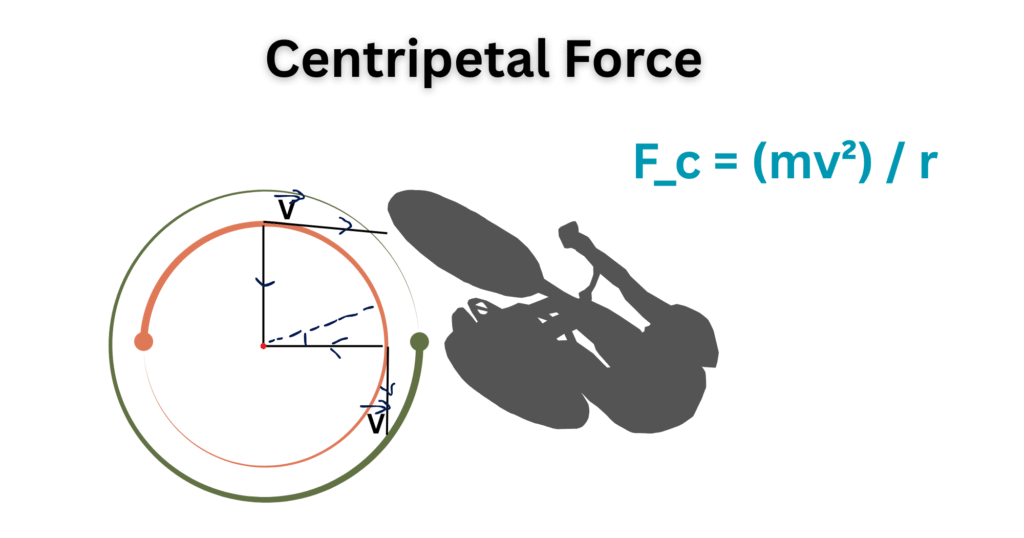What Is Centripetal Force?
Centripetal force is the force that arises due to the change in direction of an object having circular motion. Its direction is such that the motion of the object is directed towards the center. The name “centripetal” is derived from the Latin words centrum (center) and petere (to seek), which implies that this force acts towards the center. Thus this force keeps the object bound in its path. On removing the centripetal force, an object in motion loses its path and starts moving in a straight line due to inertia, as given by Newton’s First Law of Motion. Therefore, centripetal force is essential for maintaining circular motion.
Explaining simply, centripetal force is the force that keeps an object bound to a curved path and not letting it go out of the path. This force is not a new force but is the result of other forces, such as tension, gravity, or friction, acting in such a way that it pulls the object toward the center.

Understanding the Formula for Centripetal Force
The formula for centripetal force is given by,
Fc = mv2/r [Equation 1]
Where:
- Fc is the Centripetal force
- m = Mass of the object
- v = Velocity of the object
- r = Radius of the circular path
From the formula we can see that the centripetal force is directly proportional to the mass of the object and the square of its velocity. Thus increasing the mass or velocity of an object increases the centripetal force. Also, the centripetal force is inversely proportional to the radius of the circle. This means that increasing the radius of the path decreases the centripetal force and vice-versa.
Real-Life Examples of Centripetal Force
Centripetal force is observable in our daily lives and is utilized in many other fields of science and technology.
- Turning of a car in Curved Roads
When a car takes a turn on a circular road, the friction between the tires and the road provides the necessary centripetal force to keep the car on its path. If the friction is insufficient, the car may go out of the path and meet an accident.
- Swinging a Stone on a String
When we swing a stone attached to a string in a circular motion, the tension in the string acts as the centripetal force, pulling the stone towards the center of the circle.
- Satellites Orbiting the Earth
Gravity is the centripetal force that pulls satellites toward Earth and keeps their orbit.
- Roller Coasters
When a roller coaster moves in its circular path, the path’s force or its friction works as a centripetal force, allowing the coaster to complete the loop without falling.
How Centripetal Force Keeps Objects in Circular Motion
Centripetal force is responsible for keeping an object moving in a circular path by changing the direction of motion continuously. It should be remembered that the force changes the direction of motion instead of increasing the object’s speed.
For example, the velocity of a stone swinging on a string is always tangential to the circle. The stone is pulled inward and not allowed to fly off by the centripetal force produced by the tension in the string, which acts perpendicular to the velocity. Now, if the force is removed the stone will travel tangentially to the point of release on a straight line due to inertia of motion.
The Difference Between Centripetal and Centrifugal Forces
Centripetal and centrifugal forces are quite confusing because of their similar nature. However, the concept is different for both cases. Centrifugal force is an assumed force experienced in a rotating frame of reference when observed from the other frame, whereas centripetal force is the center-oriented force that holds an object in circular motion.
- Centripetal Force: It is a real force and acts toward the center of the circle.
- Centrifugal Force: It is an illusion which is observed in a non-inertial (rotating) reference frame, acting outward from the center.
For example, when a car is taking a turn in a circular road, people inside the car feel as if they are pushed outward. This sensation is created by centrifugal force in the vehicle’s non-inertial reference frame. In reality the centripetal force caused by friction between the tires and the road pulls the vehicle inward.
Applications of Centripetal Force in Everyday Life
Centripetal force plays an important role in various fields, like mechanics, medical labs, roads, parks etc. Here are some applications of centripetal force:
- Roads and Railway Tracks: Roads and railroad tracks are banked to provide the required centripetal force to the vehicles while turning. Banking on roadways allow vehicles to turn safely by giving the necessary force for friction and inclination.
- Planets and Satellites: Planets and satellites revolve constantly in their orbit due to gravity. Here gravity of the sun and planets provide centripetal force to hold planets and satellites in their orbit. Understanding this force is essential for placing artificial satellites at the required altitude with certain velocity. (Read more about Kepler’s Law of Planetary Motion)
- Sports: In sports such as javelin throw, players first spin the object before throwing it, so that it continues a circular path until thrown away. The principle of centripetal force is used here.
- In Medical Labs: In medical laboratories different fluids and materials with different densities are separated by the machines that work on the principle of centrifugal force.
- In Parks: Some swings and enjoyment purposes kept in parks like Ferris wheels and merry-go-rounds are made using principles of centripetal force to provide a safe and pleasant experience to the visitors.
Common Misconceptions About Centripetal Force
Although it is simple to define and explain, centripetal force is commonly confused. Below are some common misinformations:
- Centripetal Force Is a New Type of Force
Centripetal force is not a new type of force. It is the result of different forces, such as gravity, tension, or friction, which act together to create circular motion.
- Centrifugal Force Is Real
Centrifugal force is not a real force. It is a pseudo force which is observed in a rotating frame of reference.
- Centripetal Force Increases Speed
Centripetal force only changes the direction of motion, not the speed of the object. The speed remains constant unless it is acted upon by another force.
- An Object in Circular Motion Doesn’t Need Centripetal Force
Circular motion cannot occur without centripetal force. If this force is removed, the object will move in a straight line due to inertia.
Experiments Demonstrating Centripetal Force
There are various experiments that can be performed ordinarily to visualize and understand centripetal force.
- Swinging a Bucket of Water
Pour water in a bucket and spin it in a vertical circle. If you spin sufficiently fast, the water will not fall from the top of the swing. This shows how the centripetal force (tension in the arm) and the bucket’s velocity keeps the water in constant motion.
- Rotating a Marble in a Bowl
Put a marble in a bowl and whirl it all around. The stone remains on the periphery due to the centripetal force given by the surface of the bowl.
- Rubber Band and Weight
Tie a little weight to a rubber band and spin it in a circle. Here the tension in the rubber band acts as the centripetal force.
Conclusion
Centripetal force is a very common but important concept of mechanics which plays a vital role in circular motion. This force holds the objects in its path without letting it fall or leave the path. It is a combination of all other forces that is seen in roads and railways to planets orbiting around the sun. It has helped to continue the motion safely and smoothly. Centripetal force and centrifugal force sometimes make a dilemma. However it should be noted that centripetal force is actual force and can be calculated by its appropriate formula while centrifugal force is an illusion. Centripetal force always remains perpendicular to its track and creates a uniform circular motion. It is also widely applied in every field of science. Understanding centripetal force helps us to develop our knowledge about circular dynamics and the forces that affect our daily life.
References
Hooge, C. (2016). 6.3 Centripetal Force. BCIT Physics 0312 Textbook.
Moores, D. F. (2007). Centripetal and centrifugal forces. American Annals of the Deaf, 152(1), 3-4.
Lancu, A. (2022). Centrifugal Forces and Centripetal Forces. Tax Mag., 63.
https://byjus.com/physics/centripetal-and-centrifugal-force/
Centripetal Force
